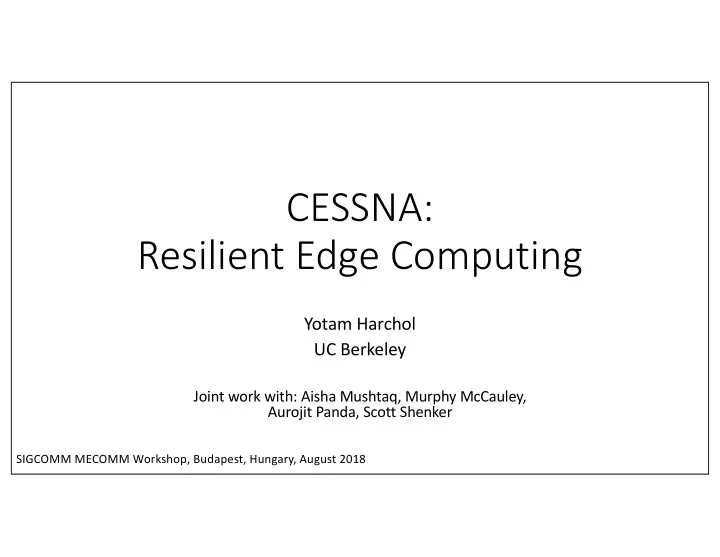

CESSNA: Resilient Edge Computing Yotam Harchol UC Berkeley Joint work with: Aisha Mushtaq, Murphy McCauley, Aurojit Panda, Scott Shenker SIGCOMM MECOMM Workshop, Budapest, Hungary, August 2018
Client-Server Computing Session Establishment Server replication Fate-sharing
Client-Edge-Server Computing Session goes through the edge ` Edge may not be reliable Edge application can be stateful State depends on packets from both sides and their interleave ordering Problem: How to maintain correctness of the state at the edge, under failover / mobility
Examples for Stateful Edge Applications Video Compression Online Data aggregation conferencing* at the edge gaming (e.g., for IoT) * Control channel is stateful, video channel may not be
Goals Correct Recovery Survivability Client Mobility High Throughput - New edge “sees” the same - Arbitrary # of lost edges Recovery may be needed Edge should provide sequence of messages - Edge failure never kills session at a remote edge high throughput - Transient “stall”
Strawman Solution #1: Replication ✓ Correct recovery Edge is replicated ✘ Survivability è Must have multiple hot backups, actively running ✘ Client mobility and consistently updated ✘ High throughput è Not applicable for client mobility
Strawman Solution #2: Message Replay Client keeps a log of its outgoing packets Server keeps a log of its outgoing packets ✘ Correct recovery ✓ Survivability Problem 1: Packet logs may become very long è can use periodic snapshots ✓ Client mobility Problem 2: Need to know the replay order between client and server packets è ?? ✓ High throughput
The Challenge of Interleave Ordering 1 Edge 1 1 Edge 4 3 2 1 1 2 3 4 Edge 2 4 3 2 1 Messages arrive at the edge 4 3 2 1 at two different sockets, The edge is a state-machine - simultaneously Faithful Replay: We want to replay Each packet changes the state messages in the exact same order (state transition) Multiple possible ordering sequences of messages Exactly the same state traversal order Multiple correct states we could be at after receiving Exactly the same correct state more than one message
CESSNA – Client-Edge-Server for Stateful Network Applications A software framework for running resilient edge applications U n N U n m o E W m o d i f d i f i e d i e d Client application Edge application Server application Your client application Your edge application Your server application comes here comes here comes here Edge API Client agent Edge Platform Server agent Client Edge Server C E S S N A F r a m e w o r k Assumptions: 1. Edge application instance per client-server session 2. Deterministic edge application: no real randomness, no multithreading within an instance
CESSNA Edge tracks ordering as it handles packets Attaches ordering information to outgoing packets Ordering Ordering Client keeps a log of its outgoing packets Server keeps a log of its outgoing packets One recovery Edge takes periodic snapshots and sends to client, or to another edge option: remote à Packet logs and ordering info are safely pruned (cold) recovery Recovery algorithm: enables faithful replay
Local Recovery Local recovery storage Ordering Designated alternate edge Two operational modes: Cold standby: Upon failure, instantiate alternate edge Hot standby: Alternate edge always running with latest snapshot
Recovery Algorithm Input: Client messages: C. ordering: 1 2 3 4 5 6 1 1 2 2 3 4 3 S. ordering: Server messages: 1 1 2 2 3 4 3 5 4 1 2 3 4 5 6 LMBS: 1 (last message before snapshot) LCMBS: 1 (last common message before snapshot) LMRC: 5 (last message received by client) LMRS: (last message received by server) 3 Edge App Client Server
Local Cache Netflix instance Netflix instance Netflix instance Netflix server Netflix instance Cache Edge
CESSNA Design (somewhat different than in the paper) Client Edge Server Edge Machine Native Application Native Application Socket Container Interposition Layer On connect() Edge Application Edge API Client Agent TCP Proxy TCP Proxy Server Agent Runtime Engine Daemon Edge Agent Data plane link Application Local Recovery Control plane link Server Cache
Edge App API Must implement: Example: Edge Compression Service recv_client_msg(data) • recv_server_msg(data) class CompressionApp(cessna_app.Application): • def __init__(self): cessna_app.Application.__init__(self) Optional: init() self.compressor = zlib.compressobj() • accept_client_connection() self.decompressor = zlib.decompressobj() • shutdown() • def recv_server_msg(self, data): decomp = self.decompressor.decompress(data) Provided: send_msg_to_client(data) decomp += self.decompressor.flush() • send_msg_to_server(data) self.send_msg_to_client(decomp) • cache_read(obj_name) • set_timeout(func, time) def recv_client_msg(self, data): • comp = self.compressor.compress(data) comp += self.compressor.flush(zlib.Z_FULL_FLUSH) self.send_msg_to_server(comp)
Initial Implementation Client Edge Server Edge Machine Native Application Native Application Socket Container Interposition Layer On connect() Edge Application Edge API Client Agent TCP Proxy TCP Proxy Server Agent Runtime Engine Daemon Blind Forwarder Edge Agent Data plane link Edge Application Local Recovery Compression Control plane link Server Cache Multiplayer Battleship IoT Aggregation
Initial Evaluation (Not part of the workshop paper) Overhead < 600 μs C,E,S co-located C,E – West US, S - varies
Snapshot Latency Overhead 1500 Snapshot Overhead [ms] 1000 500 0 0 20 40 60 80 100 120 140 Application Memory Usage [MB]
Recovery Latency Overhead 1400 For cold recovery: 1200 Docker restore: 87% (488 ms) Snapshot loading: 10% (57 ms) 1000 Recovery algorithm: 3% (20 ms) Latency Overhead [ms] 800 600 400 200 0 Local Hot Local Cold Remote Remote Remote N. Virginia N. California Frankfurt (Original edge in N. Virginia)
Future Work • Improve snapshot & recovery times • Use different edge runtimes • Use language-level snapshotting / serialization • CESSNA over HTTP – work in progress • Multiple clients per session – hard problem!
Conclusions • Consistency of stateful edge applications is challenging • State is dependent on two parties • Edge platforms are considered less reliable • CESSNA provides strong correctness guarantees • Also enables client mobility with edge • Two recovery modes for efficient recovery • Local recovery – hot / cold standby • Remote recovery • Per packet latency overhead < 700 μs
Questions? Thank you
Recommend
More recommend